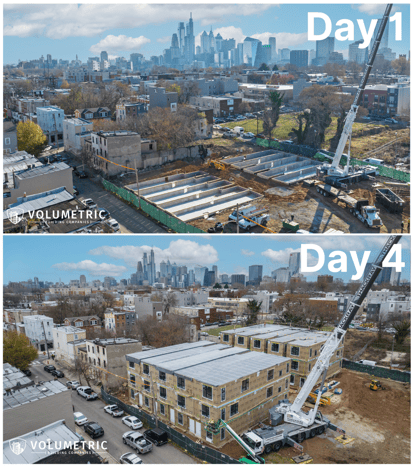Contents
.jpg?width=320&name=VBC_BerwickFacility_Manufacturing_Feb2023-23%20(1).jpg)
It’s no secret that the construction industry is facing a daunting challenge. With tech careers growing in popularity for new graduates, the skilled labor pool for trades has diminished heavily, leaving those in the construction industry overbooked and overworked. In turn, construction prices have skyrocketed, making affordable housing an even bigger challenge.
The possible solution? Off-site construction.
The Construction Labor Shortage
Just how bad is this construction labor shortage? According to ABC.org, “the construction industry will need to attract an estimated 546,000 additional workers on top of the normal pace of hiring in 2023 to meet demand for labor.”
The labor shortage is primarily attributed to several factors.
For starters, 1 in 4 skilled construction workers are older than 55, meaning at least 25% of the construction workforce will be retiring within the next decade. Normally, younger generations would fill in the gaps, but with tech continuing to rise in popularity for careers among new graduates, the construction industry finds itself in an increasingly competitive battle for young talent.
This perfect storm of circumstances has created a pressing need for construction firms to explore alternative methods and strategies to continue meeting the demand for construction services.
The impact on housing has been detrimental and will only worsen.
According to a study by the Home Builders Institute, at least 90% of builders reported a shortage of carpenters and other subcontractors. This shortage has caused labor costs to rise, in turn, making it a challenge to build affordable housing.
While the labor shortage isn’t the sole culprit behind the national housing crisis, it certainly isn’t helping. Housing affordability is currently at a 10-year low and will continue to fall as the construction workforce diminishes.
Luckily, new innovations in the construction industry have already churned up a possible solution.
What is Off-site Construction?
Off-site construction refers to the process of constructing a structure in a different location from the intended final location. This is commonly known as modular construction.
These structures can either be built from a pre-designed plan or custom-designed to the client’s needs. Once a design is finalized, the plans are sent to a factory where a team of builders assemble 95% of the units through a standardized refined process.
After the structures are completed, they’re shipped away to the site where they are installed onto the pre-prepared foundation, and all utilities are connected.
You may have seen these modular units being hauled on the freeway on long flatbed trucks or being craned in your neighborhood. Off-site construction is popular for single-family home construction, but this method of construction has been a big player in large-scale projects for decades, being used to construct anything from 500+ unit apartment complexes to hotels and everything in between. -1.png?width=4240&height=2832&name=MicrosoftTeams-image%20(62)-1.png)
Benefits of Off-site Construction
Contrary to what you might think when you hear “factory-built homes”, modular construction holds a vast range of benefits that traditional construction can barely scratch the surface of, especially when it comes to addressing the construction labor shortage.
Off-site Construction is Cost-effective
Unlike traditional construction, which often relies heavily on a specialized workforce and training, modular construction uses a standardized process that requires fewer skilled laborers, thus trimming costs significantly. Similar to most factory-built products, modular manufacturers have implemented an assembly line approach, which makes training new hires formulaic and easy.
Material costs, the second largest budget gobbler in construction, are also heavily reduced in offsite construction. Since these factories benefit from economies of scale and can order materials in bulk, they secure significant discounts that are often unattainable for on-site construction projects.
The controlled environment of these factories ensures that materials are stored and handled with precision, minimizing wastage and damage. This combination of bulk purchasing power and material management not only slashes costs but also contributes to the sustainability of construction projects by reducing resource consumption and waste, further solidifying the appeal of offsite construction.
Off-site Construction is More Efficient
In addition to cutting costs, the streamlined factory assembly line process often used in off-site construction also aids in cutting construction time.
Off-site construction is 30-50% faster than traditional construction.
Traditional construction requires the foundation and utility preparations to be completed before any of the actual structures can be started. Almost the entire traditional construction process is linear, which means that one step needs to be completed before the next can begin, elongating the construction timeline.
any of the actual structures can be started. Almost the entire traditional construction process is linear, which means that one step needs to be completed before the next can begin, elongating the construction timeline.
Using traditional construction, large-scale buildings like apartment complexes can take, on average, seventeen months to complete, and that figure can increase depending on how many units you intend to build in your complex.
Unforeseen circumstances like weather delays will also lengthen the construction timeline with the traditional method.
Clients find that one of the greatest benefits of off-site construction is that site preparation and construction in the factory can be done simultaneously, significantly cutting the timeline of the project by up to twelve months. As the units are completed in a controlled factory environment, weather delays are reduced as well.
Craning in the units takes just a couple of weeks as opposed to the months it would take for traditional construction.
Once the units are all installed, all that’s left is to connect utilities and add the finishing touches.
Offsite Construction is Easier
If you’ve ever lived in or visited a major city, we’re sure you’ve dealt with the annoying traffic that lasts for years caused by construction sites. You may have even experienced a nail or two in your tires.
Off-site construction is easier to manage and implement, especially in densely populated urban areas where traditional construction projects can lead to protracted traffic disruptions and occasional inconveniences.
With off-site construction, much of the noisy and disruptive work occurs within the confines of a factory, far removed from city streets. As a result, it not only reduces the potential for accidents and debris on roadways but also lessens the strain on urban infrastructure and commuter frustration. This approach ensures that construction projects are completed with greater efficiency and minimal disruption, making off-site construction an attractive choice for developers, local authorities, and residents alike.
Off-site Construction is Durable
A common misconception about modular construction is that the structures are cheaply made and won’t withstand the test of time.
This couldn’t be further from the truth. Modular factories are heavily regulated with quality control procedures in place to ensure top performance.
The building components, including walls, floors, and roofing, are crafted to meet or exceed the same industry standards as their on-site counterparts. Additionally, the factory environment allows for precise, controlled conditions, which often result in strong craftsmanship. These modules are built to endure the same rigorous structural inspections and safety standards as traditionally constructed buildings.
Possibilities of Off-site Construction
When people hear modular or off-site construction, they usually envision small single-family homes, but recent technology has vastly expanded the possibilities.
Modular construction is great for apartment buildings, hotels, student housing, and most other large-scale projects.
Designs for these structures have gone far beyond the blocky and boring look most associated with modular construction, delving into architecturally beautiful designs that you’d never guess were built in an assembly line.
Take this 237-unit apartment complex completed in Philadelphia, PA for example. -1.jpg?width=373&height=248&name=4233%20Chestnut%20Exterior2%20(1)-1.jpg) Both the interior and exterior of this complex showcase a unique design that rivals that of traditional constructed buildings. The design even features a fitness center, green roof, and a deck, adding additional value to the project for a fraction of the cost.
Both the interior and exterior of this complex showcase a unique design that rivals that of traditional constructed buildings. The design even features a fitness center, green roof, and a deck, adding additional value to the project for a fraction of the cost.
A project like this built through traditional methods would have required a team of highly experienced engineers, builders, and tradespeople, making the cost skyrocket, but through modular construction, each unit is speedily assembled by a team of factory workers while still maintaining quality.
As the skilled labor market further dwindles, we foresee off-site construction becoming the preferred construction method of the near future to help combat the housing crisis.
Is off-site construction right for your project?

